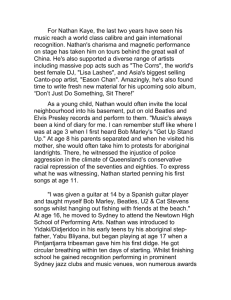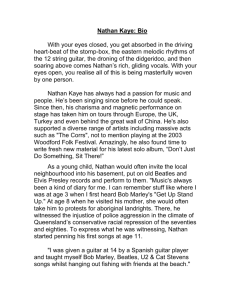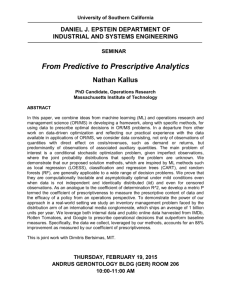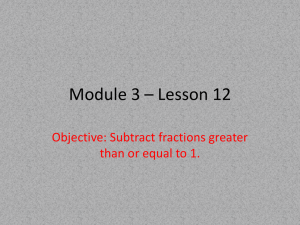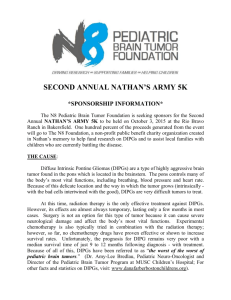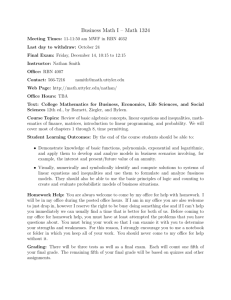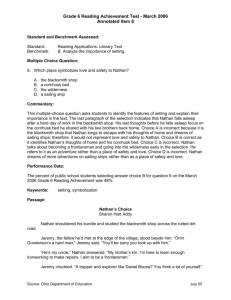Sample Present Levels Of Development Written in Functional
advertisement
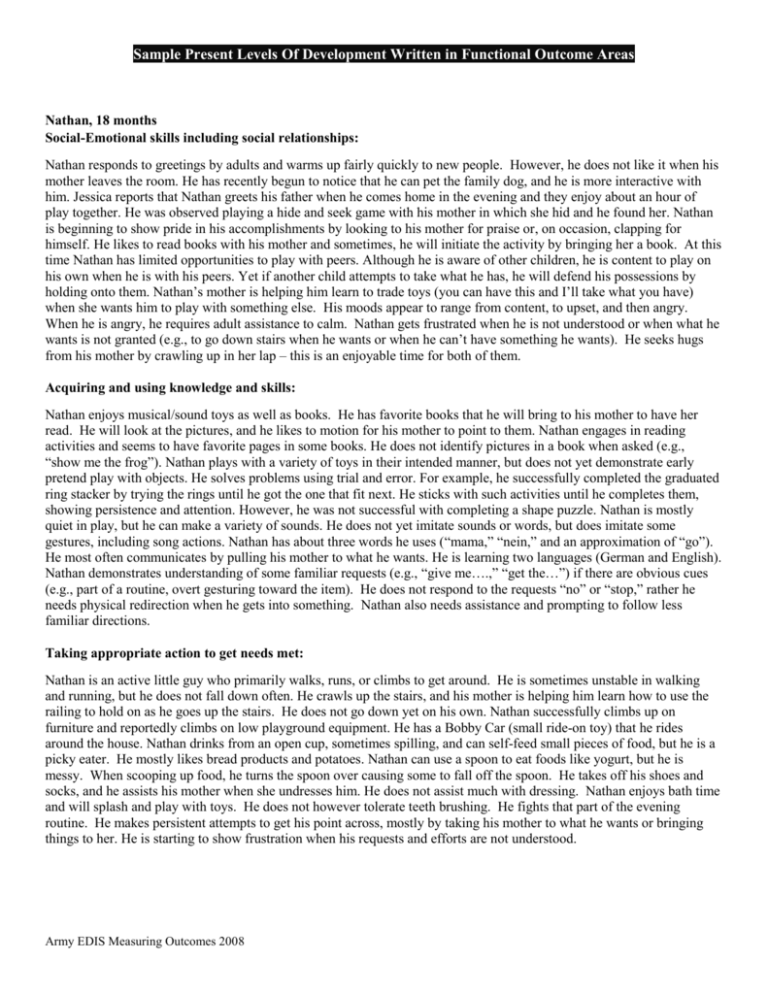
Sample Present Levels Of Development Written in Functional Outcome Areas Nathan, 18 months Social-Emotional skills including social relationships: Nathan responds to greetings by adults and warms up fairly quickly to new people. However, he does not like it when his mother leaves the room. He has recently begun to notice that he can pet the family dog, and he is more interactive with him. Jessica reports that Nathan greets his father when he comes home in the evening and they enjoy about an hour of play together. He was observed playing a hide and seek game with his mother in which she hid and he found her. Nathan is beginning to show pride in his accomplishments by looking to his mother for praise or, on occasion, clapping for himself. He likes to read books with his mother and sometimes, he will initiate the activity by bringing her a book. At this time Nathan has limited opportunities to play with peers. Although he is aware of other children, he is content to play on his own when he is with his peers. Yet if another child attempts to take what he has, he will defend his possessions by holding onto them. Nathan’s mother is helping him learn to trade toys (you can have this and I’ll take what you have) when she wants him to play with something else. His moods appear to range from content, to upset, and then angry. When he is angry, he requires adult assistance to calm. Nathan gets frustrated when he is not understood or when what he wants is not granted (e.g., to go down stairs when he wants or when he can’t have something he wants). He seeks hugs from his mother by crawling up in her lap – this is an enjoyable time for both of them. Acquiring and using knowledge and skills: Nathan enjoys musical/sound toys as well as books. He has favorite books that he will bring to his mother to have her read. He will look at the pictures, and he likes to motion for his mother to point to them. Nathan engages in reading activities and seems to have favorite pages in some books. He does not identify pictures in a book when asked (e.g., “show me the frog”). Nathan plays with a variety of toys in their intended manner, but does not yet demonstrate early pretend play with objects. He solves problems using trial and error. For example, he successfully completed the graduated ring stacker by trying the rings until he got the one that fit next. He sticks with such activities until he completes them, showing persistence and attention. However, he was not successful with completing a shape puzzle. Nathan is mostly quiet in play, but he can make a variety of sounds. He does not yet imitate sounds or words, but does imitate some gestures, including song actions. Nathan has about three words he uses (“mama,” “nein,” and an approximation of “go”). He most often communicates by pulling his mother to what he wants. He is learning two languages (German and English). Nathan demonstrates understanding of some familiar requests (e.g., “give me….,” “get the…”) if there are obvious cues (e.g., part of a routine, overt gesturing toward the item). He does not respond to the requests “no” or “stop,” rather he needs physical redirection when he gets into something. Nathan also needs assistance and prompting to follow less familiar directions. Taking appropriate action to get needs met: Nathan is an active little guy who primarily walks, runs, or climbs to get around. He is sometimes unstable in walking and running, but he does not fall down often. He crawls up the stairs, and his mother is helping him learn how to use the railing to hold on as he goes up the stairs. He does not go down yet on his own. Nathan successfully climbs up on furniture and reportedly climbs on low playground equipment. He has a Bobby Car (small ride-on toy) that he rides around the house. Nathan drinks from an open cup, sometimes spilling, and can self-feed small pieces of food, but he is a picky eater. He mostly likes bread products and potatoes. Nathan can use a spoon to eat foods like yogurt, but he is messy. When scooping up food, he turns the spoon over causing some to fall off the spoon. He takes off his shoes and socks, and he assists his mother when she undresses him. He does not assist much with dressing. Nathan enjoys bath time and will splash and play with toys. He does not however tolerate teeth brushing. He fights that part of the evening routine. He makes persistent attempts to get his point across, mostly by taking his mother to what he wants or bringing things to her. He is starting to show frustration when his requests and efforts are not understood. Army EDIS Measuring Outcomes 2008 William, 30 months Positive social-emotional development and social relationships: William is an easy going little boy who is content to play on his own, in doing so he is not distracted by other people around him, even when he is at play group or the church nursery. William shows some desire to have back and forth turntaking communication, often using gestures and nonsense words, but he does not initiate this type of interaction. He is not interested in his baby brother, but does enjoy receiving praise from his mother. William has a strong attachment to his mother. He also seems to enjoy the company of the family friend Lindsey and her dog Toad. William will pull Lindsey to bring her to things he wants her to do or play; he does this by moving Lindsey rather than asking or showing her what he wants (as if using her as an extension of himself). William will say Lindsey’s name and tries to say Toad, but it comes out “t” and is not always with intent. Just recently, William started to imitate his mother’s facial expressions, such as eyebrows up and down, but it continues to be difficult to get William to make eye contact or maintain it if he does look at her. He enjoys hugs and kisses, but his interest in this appears to be for the sensory input. William expresses ownership of his things by pulling them back. In the company of other children, William will play along side others for a short period then tends to play on his own. He will inconsistently join a group activity, but needs prompting to join. In this area, William is demonstrating skills below what is expected of children his age, although he has many emerging and foundational skills to build upon. Sparking his engagement and interaction with others will continue to be important for William. Acquiring and using knowledge and skills: William uses less than five words consistently, but mostly jabbers or pulls others to request or express himself. When asked to follow simple directions (e.g., go get, put) during the day William inconsistently responds and usually needs a prompt or assistance. He does not consistently point to request something. William demonstrates a strong attention span, especially with toys involving putting things together and taking them apart (e.g., stringing beads, nesting cups). Even when these tasks were challenging during the evaluation, he stayed with them and attempted them repeatedly without frustration. During these activities he became so focused that it was difficult to get his attention to transition him to another activity. His mother reports that he can get this way when playing with his cars or watching TV as well. William searches for objects after they are put away. His mother said that they try to play a game – hiding something in one hand for him to find. Mrs. Wonder shared that William is not yet matching colors, but he is beginning to match simple shapes. When asked to identify a big or little item he is not showing understanding of what is asked of him. Although he is not especially interested in books, he will sometimes point to pictures. If his mom tries to direct his play, he will get upset, as he prefers to play on his own. William is beginning to demonstrate some pretend play, such as acting like a dog by getting on all fours, carrying something in his mouth, and barking. A favored play activity for William is pushing his cars and putting them in and taking them out of containers, however he rarely builds on this play beyond putting in and taking out and pushing the cars. William shows skills below what other children his age are doing, this is in part due to his limited communication skills. In addition, there are concerns about the way William plays. While his attention to desired activities is encouraging, his repetitive play is a concern. Ability to take actions to get his needs met: William is an independent little guy. He goes up and down stairs by himself, runs without falling or tripping, and is learning to jump – right now he bounces up and down on both feet. William enjoys being active and engaging in roughhouse play. When playing with smaller toys and things, William uses his fingers effectively. For example he pinches the wheels of his small cars as he explores them and is learning to use a three finger grasp (like a pencil is typically held) about half of the time when he is coloring. The other half of the time, he holds the crayon in his fist with either his thumb up or down. William enjoys scribbling and tries to imitate lines and circular strokes. When it comes to meal times, William is reportedly a picky eater. He can however, use a spoon to feed himself and drink from a cup independently. To request more he pulls at his mother or hands her his cup. William can take his clothes off and actually prefers to have them off. When getting dressed William is more passive, but he will reach his arms through his shirts. William does a funny walk when his diaper is dirty and may go to his mother with a funny look on his face, but this is inconsistent and difficult to tell if he is requesting a diaper change. William’s primary means to get what he wants is to get it on his own. When he needs help, he will pull someone (most often his mom) to assist him, rather than point or express what he desires. William is quite independent at getting his needs met without calling upon the assistance of others. With the exception of using language to request and engage others, William is demonstrating a mix of skills similar to other children his age. Army EDIS Measuring Outcomes 2008
